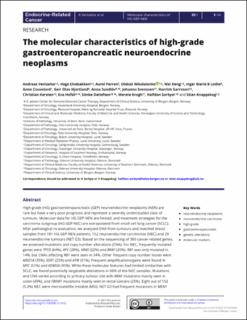| dc.contributor.author | Venizelos, Andreas | |
| dc.contributor.author | Elvebakken, Hege | |
| dc.contributor.author | Perren, Aurel | |
| dc.contributor.author | Nikolaienko, Oleksii | |
| dc.contributor.author | Deng, Wei | |
| dc.contributor.author | Lothe, Inger Marie Bowitz | |
| dc.contributor.author | Couvelard, Anne | |
| dc.contributor.author | Hjortland, Geir Olav | |
| dc.contributor.author | Sundlöv, Anna | |
| dc.contributor.author | Svensson, Johanna | |
| dc.contributor.author | Garresori, Herish | |
| dc.contributor.author | Kersten, Christian | |
| dc.contributor.author | Hofsli, Eva | |
| dc.contributor.author | Detlefsen, Sönke | |
| dc.contributor.author | Krogh, Merete | |
| dc.contributor.author | Sørbye, Halfdan | |
| dc.contributor.author | Knappskog, Stian | |
| dc.date.accessioned | 2022-03-28T15:02:50Z | |
| dc.date.available | 2022-03-28T15:02:50Z | |
| dc.date.created | 2022-01-21T19:20:57Z | |
| dc.date.issued | 2021 | |
| dc.identifier.citation | Endocrine-Related Cancer. 2021, 29 (1), 1-14. | en_US |
| dc.identifier.issn | 1351-0088 | |
| dc.identifier.uri | https://hdl.handle.net/11250/2988129 | |
| dc.description.abstract | High-grade (HG) gastroenteropancreatic (GEP) neuroendocrine neoplasms (NEN) are rare but have a very poor prognosis and represent a severely understudied class of tumours. Molecular data for HG GEP-NEN are limited, and treatment strategies for the carcinoma subgroup (HG GEP-NEC) are extrapolated from small-cell lung cancer (SCLC). After pathological re-evaluation, we analysed DNA from tumours and matched blood samples from 181 HG GEP-NEN patients; 152 neuroendocrine carcinomas (NEC) and 29 neuroendocrine tumours (NET G3). Based on the sequencing of 360 cancer-related genes, we assessed mutations and copy number alterations (CNA). For NEC, frequently mutated genes were TP53 (64%), APC (28%), KRAS (22%) and BRAF (20%). RB1 was only mutated in 14%, but CNAs affecting RB1 were seen in 34%. Other frequent copy number losses were ARID1A (35%), ESR1 (25%) and ATM (31%). Frequent amplifications/gains were found in MYC (51%) and KDM5A (45%). While these molecular features had limited similarities with SCLC, we found potentially targetable alterations in 66% of the NEC samples. Mutations and CNA varied according to primary tumour site with BRAF mutations mainly seen in colon (49%), and FBXW7 mutations mainly seen in rectal cancers (25%). Eight out of 152 (5.3%) NEC were microsatellite instable (MSI). NET G3 had frequent mutations in MEN1 (21%), ATRX (17%), DAXX, SETD2 and TP53 (each 14%). We show molecular differences in HG GEP-NEN, related to morphological differentiation and site of origin. Limited similarities to SCLC and a high fraction of targetable alterations indicate a high potential for better-personalized treatments. | en_US |
| dc.language.iso | eng | en_US |
| dc.publisher | Society for Endocrinology | en_US |
| dc.relation.uri | https://erc.bioscientifica.com/view/journals/erc/29/1/ERC-21-0152.xml | |
| dc.rights | Navngivelse 4.0 Internasjonal | * |
| dc.rights.uri | http://creativecommons.org/licenses/by/4.0/deed.no | * |
| dc.title | The molecular characteristics of high-grade gastroenteropancreatic neuroendocrine neoplasms | en_US |
| dc.type | Peer reviewed | en_US |
| dc.type | Journal article | en_US |
| dc.description.version | publishedVersion | en_US |
| dc.source.pagenumber | 1-14 | en_US |
| dc.source.volume | 29 | en_US |
| dc.source.journal | Endocrine-Related Cancer | en_US |
| dc.source.issue | 1 | en_US |
| dc.identifier.doi | 10.1530/ERC-21-0152 | |
| dc.identifier.cristin | 1987654 | |
| cristin.ispublished | true | |
| cristin.fulltext | original | |
| cristin.qualitycode | 2 | |

